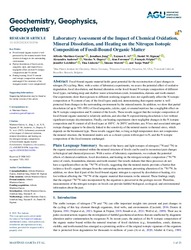Laboratory Assessment of the Impact of Chemical Oxidation, Mineral Dissolution, and Heating on the Nitrogen Isotopic Composition of Fossil‐Bound Organic Matter
DOI: https://doi.org/10.1029/2022GC010396
Persistent URL: http://resolver.sub.uni-goettingen.de/purl?gldocs-11858/10436
Persistent URL: http://resolver.sub.uni-goettingen.de/purl?gldocs-11858/10436
Supplement: https://doi.org/10.5281/zenodo.6884681
Martínez‐García, Alfredo; Jung, Jonathan; Ai, Xuyuan E.; Sigman, Daniel M.; Auderset, Alexandra; Duprey, Nicolas N.; Foreman, Alan; Fripiat, François; Leichliter, Jennifer; Lüdecke, Tina; Moretti, Simone; Wald, Tanja, 2022: Laboratory Assessment of the Impact of Chemical Oxidation, Mineral Dissolution, and Heating on the Nitrogen Isotopic Composition of Fossil‐Bound Organic Matter. In: Geochemistry, Geophysics, Geosystems, Band 23, 8, DOI: 10.1029/2022GC010396.
 |
Dokument öffnen: |
Fossil‐bound organic material holds great potential for the reconstruction of past changes in nitrogen (N) cycling. Here, with a series of laboratory experiments, we assess the potential effect of oxidative degradation, fossil dissolution, and thermal alteration on the fossil‐bound N isotopic composition of different fossil types, including deep and shallow water scleractinian corals, foraminifera, diatoms and tooth enamel. Our experiments show that exposure to different oxidizing reagents does not significantly affect the N isotopic composition or N content of any of the fossil types analyzed, demonstrating that organic matter is well protected from changes in the surrounding environment by the mineral matrix. In addition, we show that partial dissolution (of up to 70%–90%) of fossil aragonite, calcite, opal, or enamel matrixes has a negligible effect on the N isotopic composition and N content of the fossils. These results suggest that the isotopic composition of fossil‐bound organic material is relatively uniform, and also that N exposed during dissolution is lost without significant isotopic discrimination. Finally, our heating experiments show negligible changes in the N isotopic composition and N content of all fossil types at 100°C. At 200°C and hotter, any N loss and associated nitrogen isotope changes appear to be directly linked to the sensitivity of the mineral matrix to thermal stress, which depends on the biomineral type. These results suggest that, so long as high temperature does not compromise the mineral structure, the biomineral matrix acts as a closed system with respect to N, and the N isotopic composition of the fossil remains unchanged. Plain Language Summary:
The ratio of the heavy and light isotopes of nitrogen (15N and 14N) in the organic material contained within the mineral structure of fossils can be used to reconstruct past changes in biological and chemical processes. With a series of laboratory experiments, we evaluate the potential effects of chemical conditions, fossil dissolution, and heating on the nitrogen isotopic composition (15N/14N ratio) of corals, foraminifera, diatoms and tooth enamel. Our results indicate that these processes do not have a significant effect on the 15N/14N of fossils, suggesting that the mineral matrix provides a barrier that isolates a fossil's organic nitrogen from the surrounding environment, preventing alteration of its 15N/14N. In addition, we show that if part of the fossil‐bound organic nitrogen is exposed by dissolution or heating, it is lost without affecting the 15N/14N of the organic material that remains in the mineral. These findings imply that the original 15N/14N ratio incorporated by the organism is preserved in the geologic record. Therefore, measurements of the nitrogen isotopes on fossils can provide faithful biological, ecological, and environmental information about the past. Key Points:
Fossil‐bound organic matter is well protected by the mineral matrix from chemical changes in the surrounding environment.
Partial dissolution of fossil calcite, aragonite, opal, and enamel has a negligible effect on their N isotopic composition and N content.
During heating, fossil N content and isotopic composition remains unchanged if the structure of the inorganic matrix is not compromised.
Statistik:
ZugriffsstatistikSammlung:
This is an open access article under the terms of the Creative Commons Attribution License, which permits use, distribution and reproduction in any medium, provided the original work is properly cited.

